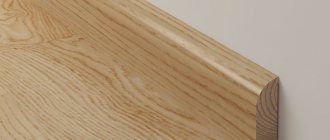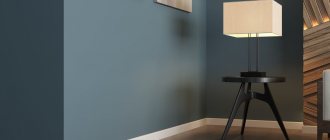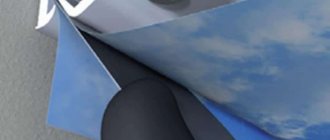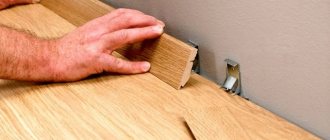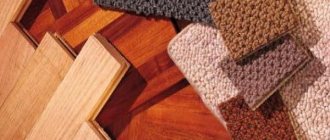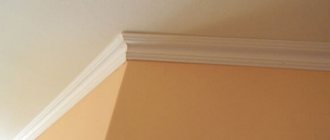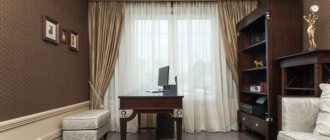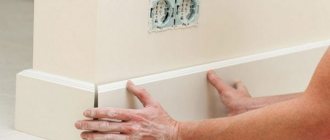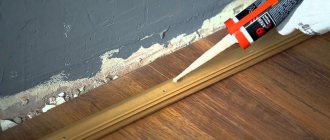The renovation cannot be considered complete unless the installation of skirting boards is carried out, aesthetically covering the line of junction between the floor and the walls of the room. When choosing this decorative element of the interior, take into account the type of finishing materials used in the room, their structure and color. Wooden skirting boards, previously used everywhere in decoration, have recently been joined by skirting boards made from plastic, ceramics and MDF boards. Moreover, the functionality of plastic skirting boards has been significantly expanded due to the modernization of their design. By installing a plinth with a cable channel, it is possible to solve the incidental problem of masking various wires running throughout the apartment. At the same time, unimpeded access to the telephone or network cable for repair or replacement is ensured due to the presence of an easily sliding decorative panel in the baseboard, under which all fasteners are also securely hidden.
What is an electrical skirting board?
A plinth with a cable channel is something between an interior element and a mounting tray for laying cables. It is used mainly in residential premises, where it is necessary to hide unattractive wiring, but at the same time leave it within minutes’ reach. It can be used if the walls are already plastered, when at the very last moment you remember that you need to lay an additional wire.
Plastic plinth with channel for wires
Wires in the baseboard: pros and cons
Laying cables in a channel is superior to other installation methods. There are a number of reasons for this:
- speed of work, because there is no need to do a classic groove;
- less construction dust;
- Wiring in the baseboard is 3-5 times cheaper than in the wall.
Stretching a cable in a baseboard is cheaper than cutting walls
. There are also disadvantages:
- laying the cable requires skill, because it constantly strives to fly out;
- a plastic floor plinth, unlike a concrete wall, does not remove heat well, meaning overheating of the wiring is possible.
Types of material
There are several main varieties of this product, each of which has its own characteristics:
- PVC plinth with cable duct is rightfully considered the most popular of all, due to its many advantages and affordability.
- Wooden floor elements. This option is not so common, because its cost is quite high.
- MDF products are not as in demand as plastic skirting boards, but they have a number of positive parameters. For example, they harmonize perfectly with laminate and solid wood.
- Aluminum parts for framing the joint between the floor and the ceiling are not suitable for every interior, but the prospects for such material are enormous.
Almost all types of floor skirting boards have models equipped with cable ducts, but PVC products are deservedly considered the most capacious.
Thus, it is possible to choose the most suitable solution.
Depending on the location of the cable channel, there are two groups of skirting boards:
- The channel is located in the center. This is the most common type. It allows you to place a small number of wires in an empty space, without the need to remove the entire panel, just separate the plug.
- The channel is located behind the removable panel. Suitable for laying fairly thick cables. The disadvantage is that you have to disconnect the entire structure.
Compared to floor skirting boards, ceiling fillets with cable ducts are less capacious and more problematic to install and repair.
Advantages of PVC options
Undoubtedly, PVC products have the most advantages compared to other varieties:
- In most cases, a plastic plinth has a channel located in the center, which makes it possible to hide the wiring even for a beginner without special skills. Installation also does not require experience.
- Many products have flexibility and rubberized lining on the edges, which allows you to completely hide small irregularities and defects.
- A rich decorative choice that is significantly superior to the aluminum or wooden option.
- Easy to use: does not absorb dirt and is easy to clean.
- There are sizes for different situations.
- Low price. Undoubtedly, it is this advantage that makes such a floor plinth accessible to most buyers.
Plastic floor edging for wiring has only one relative disadvantage - during installation it is necessary to pay special attention to protection from moisture
Profile device
The structure of any cable plinth includes two elements: a cavity for wiring and a cover. The structure fits tightly to the floor and walls. This is necessary to protect the wires from dust and moisture when cleaning. Fastening is carried out using self-tapping screws or dowel-nails 20-40 mm long.
Materials and sizes
Wood, aluminum, PVC plastic or MDF are used in production. These materials are equally easy to install and adjust to the required size. The plastic version is somewhat more durable due to its increased resistance to moisture. Wooden and MDF products are among the most expensive.
Aluminum plinth with cable channel
The standard size is considered to be a length of 2.5 m. The height and width depend on the cross-section and the number of wires laid in it.
Fire safety
Improperly installed electrical wiring is a common cause of fire. Therefore, reliable manufacturers of cable skirting boards include substances that prevent combustion and smoke emission. The most heat-resistant material is aluminum.
Installation methods
Installation of the plinth begins from the inner or outer corner (if the dimensions match, installation from the door is possible). Straight long pieces are installed first, then, after careful measurements, the remains are cut into sections mounted in niches, around columns or in finishing areas. With all methods, the plinth is cut at a right angle (in this regard, plastic materials are easier to process than wooden materials, which are adjacent at an angle of 45 °).
It is necessary to pay attention to the lack of margin in the areas where straight sections are connected with couplings (the smoother and neater the edges are, the better) and the provision of the required 3-5 mm under the joining elements for connection in the corner. Methods for installing plastic floor plinths
Methods for installing plastic floor plinths
In this case, the installation itself is performed in one of the following ways:
- With glue fit.
- Fixation with staples.
- Screwing it to the wall with self-tapping screws.
Types of skirting boards for cables
There are two types of wire trays:
- The product has a recess on the front side. The cable fits into it. After which the groove is closed with a compact lid. It can be quickly removed and returned. A good option in case new wiring is added in the future, but you don’t want to remove the entire baseboard.
- Initially, only the tray is attached to the wall. A wire is attached to it. A massive front cover is placed on the structure. The assembly turns out to be more durable and capital. Suitable for families with small children, because getting to the cables is not so easy.
Arbiton skirting board design with front cover
Technical specifications
There are several ways to produce products. Depending on the technological process, the following types of skirting boards are obtained:
- Semi-rigid. During manufacturing, the material is exposed to increased pressure, as a result of which its molecular structure changes. The longitudinal bonds in the polymer are strengthened, and the final product receives the necessary flexibility. When installed, such models bend around possible surface irregularities and do not form cracks.
- Tough. The most common finishing element. Its installation is carried out in straight sections, and corner connections are made using special elements.
- Foamed. The lightest structures with low thermal conductivity. Due to this, they are often used as additional thermal insulation.
How to lay electrical skirting boards
Before starting work, you should calculate the required length of wires. It is better to purchase them with a margin of 10-20%. Then the type and length of the baseboard itself is selected. In this case, it is worth paying attention to how many and what cross-sectional conductors will be laid in it. At the same time, it is important to take into account color and design.
Preparation of the workplace
Before installing a new electrical skirting board, it is necessary to disassemble the old one. Crude tools such as a pry bar or a heavy-duty screwdriver are suitable for this. The workplace is cleared of debris, dust and dirt. If necessary, the defects in the corner between the floor and the wall are covered with putty.
Next, the new channel is applied to the installation site. It is more convenient to do this together. Mark the mounting holes on the wall with an awl or pencil. They must be done with a hammer drill in impact mode.
Removing the old baseboard
Installation of cable channel
A plinth with a channel for wiring can be easily installed even by a person without experience. There are several important points to consider:
- To determine the required length, you need to calculate the perimeter of the room. You need to subtract the width of the doorway from the obtained value, because the corner tray will not be laid in it.
- It is better to fasten the dowel using nails or self-tapping screws, since the glue is too demanding on the materials it holds together.
- Corners and various adapters. If you forget to install at least one, the structure will have to be disassembled and reinstalled.
Installing the Removable Cover
The cover is installed with latches. This method is convenient and does not require third-party tools. The successful closing of the lid can be judged by a characteristic click. It is important to ensure that there are no gaps left. Therefore, after snapping the cover into place, its correct position is checked visually or by touch.
Plastic skirting board with snap-on lid
Skirting board with separate front part
This type includes products made from MDF. The fastening strip is installed strictly parallel to the floor. It is better to monitor the accuracy of measurements using a level. Or you can resort to a life hack. Cut two small fragments from the front part and use them as templates (samples, standards) when installing the mounting strip.
How to start and remove wiring
To remove the cable from the baseboard, you can use one of three methods:
- Carefully cut the groove in the required location. The method requires skill and is dangerous to perform, because the knife blade can easily slip off your fingers.
- Drill a hole. It will turn out neatly. But it can only be done if you have a thin drill of the required diameter at hand.
- In the place where the wire is removed, slightly heat the plastic with a lighter and carefully press the groove under the wire. This method should be used only with knowledge of the matter and some experience. However, the end result is the most aesthetically pleasing.
Cable pulling in the baseboard
Installation of sockets
Expensive manufacturers often produce sockets that are sized specifically for their electrical baseboards. In this case, installation is the simplest. There is no need to cut anything or adjust it to fit. Universal sockets are also available for sale. For them, you will have to cut off part of the baseboard and carry out more complex work. In terms of money, the second option will be cheaper.
Box for socket on baseboard
Advantages of plastic framing
Central location of the cable channel
Plastic skirting boards with a cable channel can be:
- With a central channel for laying wires;
- With a channel placed in the upper part, which can be removed.
Skirting board, with removable top part and cable channel
By choosing a plastic plinth with a cable channel, you get reliable communications and a pleasant appearance. In addition, plastic skirting boards have a huge number of advantages:
Possibility to hide electrical wiring; Easy to install. There are no special requirements for the type of flooring, no special skills are required; Easy dismantling. If necessary, a new cable can be easily laid and fixed. At the same time, the elements do not lose their qualities; Flexibility
This quality is especially important for those with uneven floors. And the presence of a rubber gasket, which ensures a tight fit to the floor, makes such a plinth irreplaceable; A wide range of colors, thanks to which you can choose the planks to suit absolutely any interior; Practicality and unpretentiousness
Easy to clean using cleaning products; Resistance to direct sunlight; Cheapness. A plastic plinth with a cable channel is slightly higher in cost than a traditional one, but cheaper than a wooden one.
Color range of plastic skirting boards
Product sizes
The floor plinth with cable duct has several standard sizes:
- Wooden parts up to 80 mm wide. It is the tall elements that often have the necessary space for wires. The length of the plinth varies from 200 to 300 cm.
- The dimensions of aluminum products are similar to the previous type.
- MDF and plastic floor plinth have a width from 40 to 120 mm and a standard length of 250 cm.
Much depends on the manufacturer. Of course, it is necessary to take into account the availability of specific products in hardware stores.
The appearance and dimensions of the plinth do not always correspond to the capacity of the cable channels
Flaws
There are also certain disadvantages of laying cables in the baseboard. These include low heat dissipation from internal structural elements. If the wire is located in channels in the thickness of the wall, this figure will be much higher. This feature significantly reduces the scope of application of such structures. The plinth cannot be used for wires whose rated load exceeds 3.5 kW.
It is almost impossible to lay several three-core wires with a cross-section of each element of 2.5 mm² inside the cable channel. It will be much easier to lay such wires in the groove.
When choosing the installation of electrical communications when using a plinth, you cannot connect sockets in series. Each of them must have a separate line. Otherwise, the system may overheat. This is a fire hazard. If the requirements of building codes and regulations are not observed, such installation can lead to a short circuit. This threatens the life and health of people and their property.
Preparation
Much attention must be paid to the preparation stage. Due to the fact that the plastic skirting board is installed on decorated surfaces, the installation site is already ready for work
But you need to select the necessary components:
Corner pads. They make it possible to make corner connections without cutting parts. This option allows you to get rid of tedious trimming and get a more aesthetic appearance. For this process, caps are provided for internal and external corners.
End caps. Often the floor plinth ends next to the doorways, but there are other areas, for example, built-in furniture. It is to form a beautiful ending that caps are used. It should be taken into account that they come in left and right versions.
Butt joints. Used to hide the junction of two parts
They have small grooves into which each of the edges of the planks is installed. It is important to take into account that this option creates a visual separation of the overall canvas.
Accessories for plastic skirting boards
Before attaching plastic skirting boards to the surface, you should also prepare the tools necessary for the job. An individual set is selected for each specific situation.
Tips and tricks
To speed up and improve the quality of work it is possible to:
- Place all fasteners and fittings in separate, durable but lightweight boxes and move them to the desired areas.
- Be the first to secure the planks that do not require cutting and hide the joining elements, for example, with furniture.
- Allow at least a 10 mm margin along the length of the section if it is impossible to check the accuracy of the profile marking by applying it to the wall.
- Make your own jig device for evenly spaced holes of the same height when mounting on clips or dowels.
- Pierce holes in the plastic with an awl or screwdriver after preparing the holes in the walls, strictly along the line of screwing the fasteners.
- Provide for the possibility of securely fastening the profile in corner areas (it is not recommended to drill a hole at the edge for fixation).
- In areas where contact is possible, corner and end caps should be reinforced using a small amount of high-adhesive adhesive or clear sealant.
In rare cases, the baseboard can be painted. This situation is possible in two cases:
- A polyurethane flexible profile in white or light gray was chosen deliberately when planning to paint the walls and baseboards in the same tone.
- The old plastic baseboard does not match the interior after renovation or has lost its appearance.
Painting the baseboard
Successful painting of old hard plastic skirting boards is possible provided that nitro enamels with high adhesion and hiding power are applied; paints of these brands in spray cans are effective. In all other cases, the coating simply peels off the plastic over time.
Application of nitro enamel
In the case of painting an already fixed baseboard, the walls and floor are covered in advance with film and masking tape.
Fire safety
Most electrical cables are made of plastic, which raises questions about fire safety. If you don’t take into account the very cheap options on the market, all the rest are made of plastic, which does not support or propagate combustion. More serious material is used. From a fire safety point of view, such an electrical baseboard is an acceptable option.
Electrical safety is guaranteed subject to cable operating conditions
Well, to be sure of fire safety, also take cables with a spare cross-section and in non-flammable sheaths. And it is cables, not wires, when it comes to wiring. There is a difference and not only in price.
